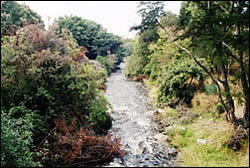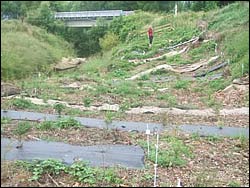Riparian vegetation enhancement
Research Status: Ongoing |
Riparian vegetation |
Introduction
The Sherry River Landcare group formed in July 2001 initially in response to water quality monitoring findings that indicated that the Sherry River had high bacterial contamination. This led to "cow-crossing" experiments in the Sherry River.
The Landcare group has since come together over a number of issues, including the management of old man's beard (Clematis vitalba) which dominates much of the riparian environment. The group is keen to begin rehabilitation of their catchment, and to assist with the establishment of plantings alongside the Sherry River. Their aim is to commence rehabilitation where existing willow trees have been removed by the Tasman District Council (TDC) in the areas identified from the vegetation classification (described below) as having good enhancement opportunities.
Research Approach
Areas of existing native riparian vegetation in the Sherry River catchment were located by Lisa Langer, as the first step of identifying areas suitable for native vegetation enhancement. Farmers and TDC need to know what to plant and how to manage riparian vegetation, in particular the best methods to control weeds.
The farmers were keen to see simple trials established using a variety of plants and techniques. Assessments will be made of their performance, to determine the best way of achieving a variety of objectives, such as bank stability, biodiversity, habitat provision, and weed (particularly old man's beard) suppression. Results that determine the most appropriate techniques for the area, together with the establishment of a demonstration area, should encourage other farmers to follow the lead.
The prime objective of the treatments is to determine the best, most cost-effective means for controlling weeds. The whole site was pre-plant sprayed prior to planting. The treatments are:
A. Control (no further weed control)
B. Control, plus on-going weed control for 2 years
C. Wool carpet mat (for weed control)
D. Weed mat (for weed control)
The trial layout is a split-plot design with 10 replications. Species will be planted in rows at 1 m x 1 m spacings, with treatments applied in rows at right angles to the species rows. In order to reduce edge effects between treatments, every second treatment row is the same treatment (treatment B). The remaining three treatments, plus the six species (a), are randomly located within each replicate. The remaining species (b and c) are planted in spare space left over after the 10 replicates were allocated the most uniform planting sites (b), and on the bank alongside the river.
Research Results
Up-date - October 2008
The main purpose of this visit was to plant the Booth trial area in another part of the Sherry River catchment, to measure the + and - weed control trial on the North bank at the Bavinís, and to inspect a possible wetland management site on Lisa Savageís property.
Up-date - April 2008
The broad conclusion from this preliminary trial suggests that there is no simple solution for successfully establishing native species in weedy environments, such as exist alongside the Sherry River. The use of fast-growing species planted as high quality seedlings, followed up with good weed control by means of herbicides, and mulches of carpet and weedmat, will assist early survival and growth rates over the first 2 years. However, further weed control is most likely to be required before adequate and long-term native species dominance of the site is achieved.
Up-date - July 2007
There had been good growth over the last year with some plants now over 2 m. Once again there is frost damage to karamu (Coprosma robusta) and to a lessor degree on koromiko (Hebe salicifolia) and kohuhu (Pittosporum tenuifolium). These species will recover come spring. Also measured but not part of the trial were koromiko, flax (Phormiun tenax), toitoi (Cortaderia richardii) & purei (Carex secta). The flax, toitoi & purei were all growing well. These should help stabilise the bank over the long term.
Up-date - December 2005
Three months after planting (2 months since the last spray application), the native plants looked in reasonable to good health. The species hit by frost soon after planting (wineberry and karamu) still had 50% or less survival, but many of those still alive were growing from the base. Most of the kanuka had dead tops, but were recovering in their lower halves. The majority of the remaining plants had established well.
 |
 |
Lisa Langer talking about riparian enhancement - 2004 AGM |
Riparian trial at Bavins, Sherry River |
Recent Publications
Recent Presentations
BMPs, BEPs and Guidelines
| Title | Description |
| Sustainable Indigenous Forest Guidelines | |
| Southland’s Wetlands assessment Guide | A tool kit for use by landowners that includes practical advice and assistance to encourage the main...More » |
| Best practice guidelines for vegetation management and in stream works | These best practice guidelines cover activities undertaken by the River and Catchment Services group...More » |
| A Guide to Managing Waterways on Canterbury Farms | Environment Canterbury has produced a set of riparian guidelines for the management of smaller water...More » |
| Riparian Zone Management Guidelines |
From document: This Guideline is a practical manual for use by landowners, developers, organis...More » |
| Riparian Zone Management Planting Guide | Companion Guide to "Riparian Zone Management Guidelines"...More » |
| Managing Riparian Zones: A contribution to protecting New Zealand´s rivers and streams. Volume 1: Concepts | The handbook was prepared by the National Institute of Water and Atmospheric Research(NIWA), with th...More » |
| Managing Riparian Zones: A contribution to protecting New Zealand´s rivers and streams. Volume 2: Guidelines | The handbook was prepared by the National Institute of Water and Atmospheric Research(NIWA), with th...More » |
| Waitakere District Plan Guidelines – Natural Areas | Riparian margins...More » |
| Native Plants for Streamsides in Wellington Conservancy |
Guideline helps reduce further loss of indigenous biodiversity by indicating the native plants ...More » |
| Trees on Farms: A guide with local experience of growing trees in the Waikato Region |
From website: This manual covers a range of aspects of selection, establishment and care of tr...More » |
Primary Contacts:

|
Lisa Langer
Email Phone: 03 364 2949 Fax: 03 364 2812 |
Institute Ensis (formerly Forest Research) |
Expertise Riparian vegetation |

|
Nick Ledgard
Email Phone: 03 364 2949 |
Institute Scion |
Expertise forestry, plant trials |

|
Chris Phillips
Email Phone: +64 3 321 9775 More details» |
Institute Landcare Research |
Expertise Erosion processes, slope stability, effects of forestry, catchment management, knowledge management |